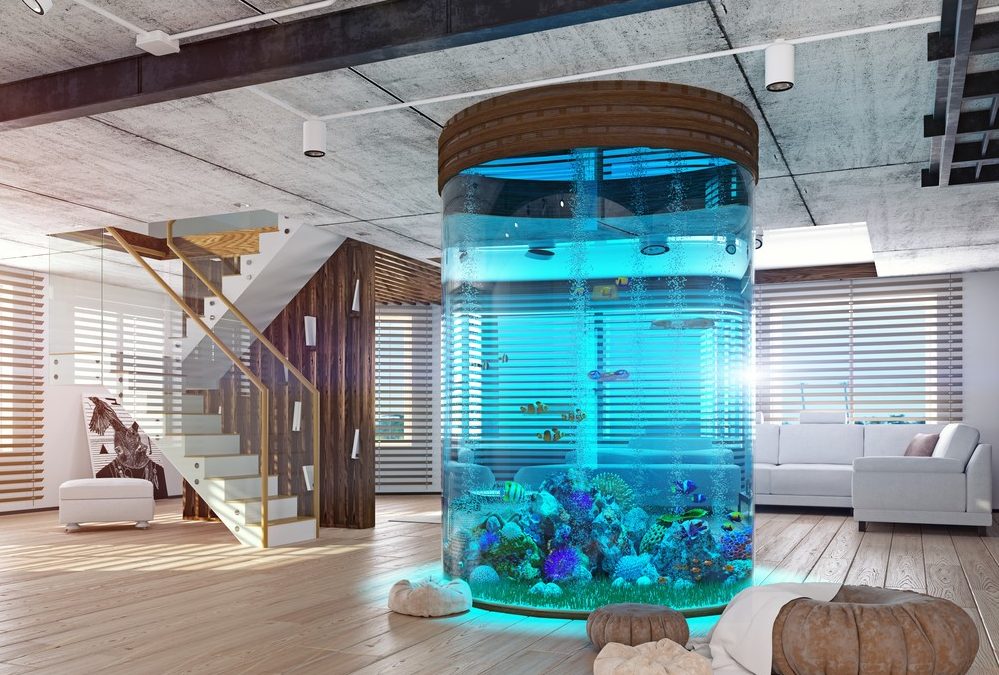DIY PART 3 – WHAT SIZE AQUARIUM IS BEST?
I wish this were a simple answer but, unfortunately bigger is not always better. To make matters worse, the smallest aquariums are not always best either! Aquariums for sale at your local fish store range in size from 1 gallon to 350 gallons. They also range in shape from spheres and cylinders to mazes and wrap arounds. And that’s not even counting the hundreds of custom aquarium possibilities. Are you overwhelmed yet? Great! Let’s get down to business, what size aquarium is best for YOU?
SIZE OF THE AQUARIUM
In the last article, Why Do You Want an Aquarium?, you determined your motives behind purchasing a new aquarium. With that in mind, we can begin to compare small and large aquariums. First, is there a particular fish or aquarium invertebrate that you just couldn’t live without? If so, you must first determine the tank requirements for this inhabitant. For example, it is recommended that a full grown Hippo Tang (Dory fish) live in an aquarium no less than 180 gallons with a length of at least 6 feet. There are stories of the Hippo Tang living happily in much smaller aquariums such as the 100 and 125 gallon options. But, for a healthy and happy full grown specimen, these should be kept in the recommended 180-gallon aquarium with lots of swimming room.
Next, if you don’t have a particular fish that you’re after, the best way to determine what aquarium size is best for you is the COST. The boisterous dollar amounts in the aquarium trade seem to scare off the faint of heart. Marine fish can be purchased from your local retail store ranging anywhere from $15 to $250. Some rare species even warrant a price of tag of $650. Be prepared to spend, on average, $60-70 for saltwater aquarium fish. Generally speaking smaller aquariums are going to cost less than large aquariums. But, the smaller aquariums are actually harder to care for! This is because any imbalance or mishap in a small aquarium is quickly magnified and harder to fix. Smaller aquariums are not recommended for beginner aquarists.
Larger aquariums are more expensive but much easier to care for. A good size for a beginner aquarist ranges from 75-125 gallons. There are many different options for fish and inhabitants that can go into these aquariums and these are common sizes which can also quickly be sold for an upgrade down the road.
SHAPE OF THE AQUARIUM
Most people aren’t aware but the shape of an aquarium is a very important factor to consider which one you should purchase. The most common shape is the familiar rectangular prism. Other options that are readily available are cubes, spheres, cylinders and inverted rectangular prisms (taller than they are long). Some marine animals have certain requirements for the shape of the aquarium. If you’ve ever been to your local aquarium exhibits you’ve most likely seen Jellyfish in an aquarium resembling that of a washing machine for your clothes. The jellyfish tanks are setup like that so that they receive a constant flow closely resembling the water current they would normally receive from the ocean. Aquarium shark species prefer aquariums without 90 degree angles which would inhibit them from swimming freely. All problems can be avoided with a little research and friendly advice beforehand!
Keep in mind, for those seeking to setup a reef aquarium, the taller an aquarium is, the harder it will be to grow corals at the bottom of the tank. Water has a way of distorting the necessary light rays needed for corals to grow. If you want corals to be your main attraction in the aquarium, don’t buy a 6-foot-tall tank.
There are many beautiful rimless aquariums available these days. We love them! They provide a great clean, sharp and elegant look to any aquarium. But, keep in mind the dangers that go along with this as well. If you have pets or kids around the house, what’s to stop them from getting in? Kids also like to swing, make sure your toddlers can’t grab ahold of the edge and break the glass or pull the aquarium on top of themselves! If you have pet hairs or dust floating around your home, expect seemingly all of them to somehow end up on the top of the water in your aquarium. Some fish are also notorious for jumping! Remember, fish can commit suicide too.
ACRYLIC OR GLASS?
Glass aquariums are the most common these days. To the uninformed, it may seem surprising that a glass aquarium will cost less than an acrylic aquarium of the same size and shape. Acrylic aquariums provide a better viewing experience and strongly reduce the risk of leaking or cracking. Even though acrylic aquariums scratch easier than glass aquariums, the scratches can be buffed out unlike a glass aquarium. I recommend looking at an acrylic and glass aquarium, see if the viewing experience is better in either circumstance. The added expense of an acrylic aquarium over a glass one may not be necessary for you.
LOCATION OF YOUR AQUARIUM
Some people know exactly where they want their aquarium to go. They’ve thought through the troubles of sunlight, they’ve considered the room temperature as well as their children and pets. Others may want to purchase aquarium first, figure out the details later. Here are some tips on positioning your aquarium. Keep it in a room that you don’t have to worry if your child is putting their hands into or if the cat is looking to catch an extra meal. Keep away from large windows if possible. Direct sunlight not only heats up the aquarium to an unsafe and unstable level but, the sun’s rays will add to the speed of your algae growth. Don’t keep the aquarium in your man cave or craft room out in the garage either. A hot summer day can heat up the garage to unsafe temperatures for your fishy friends.
USED OR NEW?
New aquariums seem to be the most popular in the aquarium industry, you can easily spend $5,000-$10,000 on a new aquarium setup. These aquariums are nice because they also come with peace of mind. You don’t have to worry about what the previous owner rigged to get it working. You have your very own blank canvas to do with as you please. Most new aquariums also come with a limited warranty that used aquariums wont have.
Used aquariums have their advantages too of course! You can save a boatload of money on a used aquarium compared to a new aquarium. If you watch your local Craigslist ads you can even find the occasional poor soul whose spouse is fed up with the addictive hobby and has demanded the aquarium to be gone in the next 24 hours. You’ve got to be prepared for these though. Always take the time to make sure the aquarium holds water and the equipment is functional. Find out how long the aquarium has been setup. If purchasing a light fixture with the aquarium, take into consideration when and if the bulbs will need to be replaced.
SUMMARY
You’ve got plenty of choices for your aquarium. I recommend taking a trip to each of your local aquarium retail stores and an aquarium exhibit near you if it’s available. Take note of the aquariums that are the most appealing to you. Find answers to important questions like; is this an acrylic or glass aquarium? How thick are the walls on this aquarium? What kind of lighting is used?
We wish you the best of luck as you continue on your journey to aquarium ownership! If you have any questions whatsoever, please feel free to send us a message from our Contact Us page.

